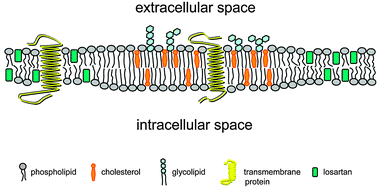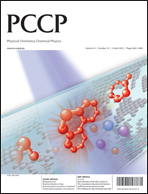Losartan's affinity to fluid bilayers modulates lipid–cholesterol interactions
Abstract
Losartan is an angiotensin II receptor antagonist mainly used for the regulation of high blood pressure. Since it was anticipated that losartan reaches the receptor site via membrane diffusion, the impact of losartan on model membranes has been investigated by small angle X-ray scattering. For this purpose 2–20 mol% losartan was incorporated into dimyristoyl-phosphatidylcholine (DMPC) and palmitoyl-oleoyl-phosphatidylcholine (POPC) bilayers and into their binary mixtures with cholesterol in the concentration range of 0 to 40 mol%. Effects of losartan on single component bilayers are alike. Partitioning of losartan into the membranes confers a negative charge to the lipid bilayers that causes the formation of unilamellar vesicles and a reduction of the bilayer thickness by 3–4%. Analysis of the structural data resulted in an estimate for the partial area of losartan, ALos ≈ 40 Å2. In the presence of cholesterol, differences between the effects of losartan on POPC and DMPC are striking. Membrane condensation by cholesterol is retarded by losartan in POPC. This contrasts with DMPC, where an increase of the cholesterol content shifts the partitioning equilibrium of losartan towards the aqueous phase, such that losartan gets depleted from the bilayers from 20 mol% cholesterol onwards. This indicates (i) a chain-saturation dependent competition of losartan with lipid–cholesterol interactions, and (ii) the insolubility of losartan in the liquid ordered phase of PCs. Consequently, losartan's action is more likely to take place in fluid plasma membrane patches rather than in domains rich in cholesterol and saturated lipid species such as in membrane rafts.


 Please wait while we load your content...
Please wait while we load your content...